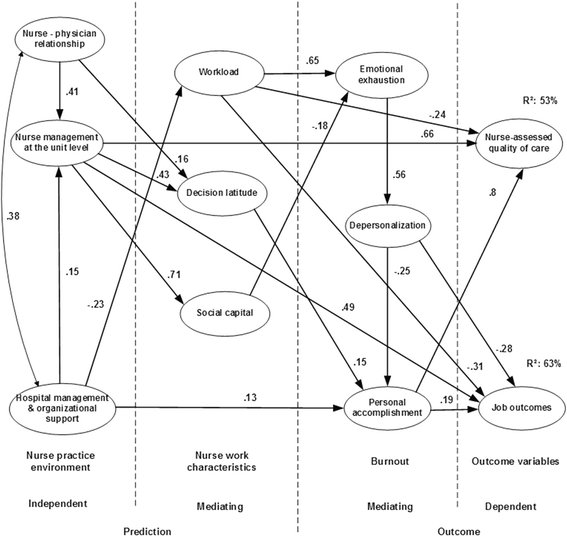Predictors of burnout, work engagement and nurse reported job outcomes and quality of care: a mixed method study
- PMID: 28115912
- PMCID: PMC5241948
- DOI: 10.1186/s12912-016-0200-4
Predictors of burnout, work engagement and nurse reported job outcomes and quality of care: a mixed method study
Abstract
Background: High levels of work-related stress, burnout, job dissatisfaction, and poor health are common within the nursing profession. A comprehensive understanding of nurses' psychosocial work environment is necessary to respond to complex patients' needs. The aims of this study were threefold: (1) To retest and confirm two structural equation models exploring associations between practice environment and work characteristics as predictors of burnout (model 1) and engagement (model 2) as well as nurse-reported job outcome and quality of care; (2) To study staff nurses' and nurse managers' perceptions and experiences of staff nurses' workload; (3) To explain and interpret the two models by using the qualitative study findings.
Method: This mixed method study is based on an explanatory sequential study design. We first performed a cross-sectional survey design in two large acute care university hospitals. Secondly, we conducted individual semi-structured interviews with staff nurses and nurse managers assigned to medical or surgical units in one of the study hospitals. Study data was collected between September 2014 and June 2015. Finally, qualitative study results assisted in explaining and interpreting the findings of the two models.
Results: The two models with burnout and engagement as mediating outcome variables fitted sufficiently to the data. Nurse-reported job outcomes and quality of care explained variances between 52 and 62%. Nurse management at the unit level and workload had a direct impact on outcome variables with explained variances between 23 and 36% and between 12 and 17%, respectively. Personal accomplishment and depersonalization had an explained variance on job outcomes of 23% and vigor of 20%. Burnout and engagement had a less relevant direct impact on quality of care (≤5%). The qualitative study revealed various themes such as organisation of daily practice and work conditions; interdisciplinary collaboration, communication and teamwork; staff nurse personal characteristics and competencies; patient centeredness, quality and patient safety. Respondents' statements corresponded closely to the models' associations.
Conclusion: A deep understanding of various associations and impacts on studied outcome variables such as risk factors and protective factors was gained through the retested models and the interviews with the study participants. Besides the softer work characteristics - such as decision latitude, social capital and team cohesion - more insight and knowledge of the hard work characteristic workload is essential.
Keywords: Burnout; Job satisfaction; Quality of care; Sensitizing concepts; Structural equation model; Turnover intentions; Work engagement.
Figures


Similar articles
-
The relationship between nurse practice environment, nurse work characteristics, burnout and job outcome and quality of nursing care: a cross-sectional survey.Int J Nurs Stud. 2013 Dec;50(12):1667-77. doi: 10.1016/j.ijnurstu.2013.05.010. Epub 2013 Jun 16. Int J Nurs Stud. 2013. PMID: 23777786
-
Nursing unit teams matter: Impact of unit-level nurse practice environment, nurse work characteristics, and burnout on nurse reported job outcomes, and quality of care, and patient adverse events--a cross-sectional survey.Int J Nurs Stud. 2014 Aug;51(8):1123-34. doi: 10.1016/j.ijnurstu.2013.12.009. Epub 2013 Dec 30. Int J Nurs Stud. 2014. PMID: 24444772
-
Nurse work engagement impacts job outcome and nurse-assessed quality of care: model testing with nurse practice environment and nurse work characteristics as predictors.Front Psychol. 2014 Nov 13;5:1261. doi: 10.3389/fpsyg.2014.01261. eCollection 2014. Front Psychol. 2014. PMID: 25431563 Free PMC article.
-
Personal and work-related factors associated with nurse resilience: A systematic review.Int J Nurs Stud. 2019 May;93:129-140. doi: 10.1016/j.ijnurstu.2019.02.014. Epub 2019 Mar 5. Int J Nurs Stud. 2019. PMID: 30925279
-
Evaluation of nurse-reported missed care in a post-anesthesia care unit: A mixed-methods study.J Nurs Scholarsh. 2024 Jul;56(4):542-553. doi: 10.1111/jnu.12975. Epub 2024 Apr 16. J Nurs Scholarsh. 2024. PMID: 38627908 Review.
Cited by
-
Role of Global Self-Esteem, Professional Burnout and Selected Socio-Demographic Variables in the Prediction of Polish Nurses' Quality of Life - A Cross-Sectional Study.Risk Manag Healthc Policy. 2020 Jun 26;13:671-684. doi: 10.2147/RMHP.S252270. eCollection 2020. Risk Manag Healthc Policy. 2020. PMID: 32617029 Free PMC article.
-
Empathy, Affect and Personality as Predictors of Engagement in Nursing Professionals.Int J Environ Res Public Health. 2021 Apr 13;18(8):4110. doi: 10.3390/ijerph18084110. Int J Environ Res Public Health. 2021. PMID: 33924629 Free PMC article.
-
Perception of the image of the nursing profession and its relationship with quality of care.BMC Nurs. 2022 Mar 10;21(1):57. doi: 10.1186/s12912-022-00830-4. BMC Nurs. 2022. PMID: 35272645 Free PMC article.
-
Nurse staffing levels within acute care: results of a national day of care survey.BMC Health Serv Res. 2022 Apr 13;22(1):493. doi: 10.1186/s12913-022-07562-w. BMC Health Serv Res. 2022. PMID: 35418056 Free PMC article.
-
Primary drivers and psychological manifestations of stress in frontline healthcare workforce during the initial COVID-19 outbreak in the United States.Gen Hosp Psychiatry. 2021 Mar-Apr;69:20-26. doi: 10.1016/j.genhosppsych.2021.01.001. Epub 2021 Jan 10. Gen Hosp Psychiatry. 2021. PMID: 33485091 Free PMC article.
References
LinkOut - more resources
Full Text Sources
Other Literature Sources

